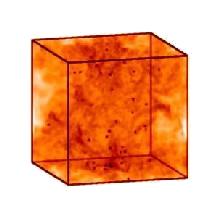 In order to follow the evolution of a dense stellar system, one has to
know (or choose) the initial conditions of that system. Traditionally,
the starting points have been Plummer or King models, i.e. systems
which include only zero-age main sequence stars evenly distributed
throughout the cluster, and no gas, star formation, or proto-stellar
disks. However, we know that most of these assumptions are at best
simple and at worst downright wrong.
In order to follow the evolution of a dense stellar system, one has to
know (or choose) the initial conditions of that system. Traditionally,
the starting points have been Plummer or King models, i.e. systems
which include only zero-age main sequence stars evenly distributed
throughout the cluster, and no gas, star formation, or proto-stellar
disks. However, we know that most of these assumptions are at best
simple and at worst downright wrong.
Modern star formation theory considers supersonic interstellar turbulence, ubiquitously observed in star forming molecular clouds, as controlling agent for stellar birth. In this picture, essentially all properties of nascent star clusters depend on the interplay between gravity the turbulent velocity field. Inefficient, isolated star formation will occur in regions which are supported by turbulence carrying most of its energy on very small scales. Clusters of stars build up in molecular cloud regions where self-gravity overwhelms turbulence, either because such regions are compressed by a large-scale shock, or because interstellar turbulence is not replenished and decays on short timescales. Rich star clusters, thus, are expected to form highly-substructured and with dynamical interactions between protostars becoming common. This modifies the mass accretion rates, leads to mass segregation, and influences the resulting IMF, all with important consequences for the subsequent evolution of the cluster.
A full understanding of star cluster evolution needs to take the
formation processes into account. A complete and comprehensive
numerical description of star cluster evolution, therefore, requires
the combination with (or at least input from) realistic gasdynamical
models of molecular cloud fragmentation and star cluster build-up.
| WG home page: | WG1 |
| Contact: | Ralf Klessen |